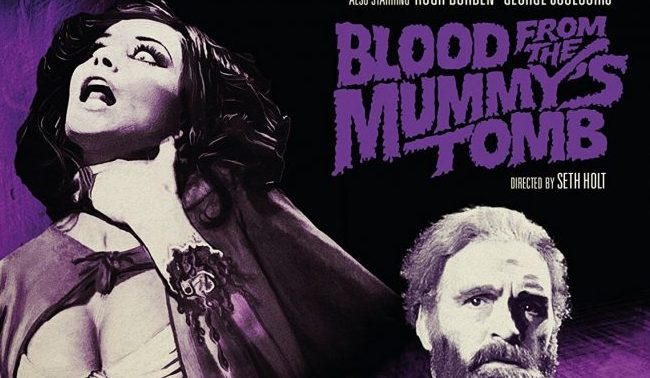
Blood From the Mummy’s Tomb (1971) DVD Review

Blood From the Mummy’s Tomb (1971) is one of Hammer Films better efforts of the 1970s. It was also the studio’s fourth Mummy film (the previous ones being The Mummy, 1959, The Curse of the Mummy’s Tomb, 1964 and The Mummy’s Shroud, 1967) and interestingly the first not to have a lumbering bandaged Mummy knocking off the cast (as well as being the first without Hammer regular Michael Ripper in a support role). While there are still several plot elements that are similar to it’s predecessors, the script origin is an adaptation of Bram Stoker’s (yes, that Bram Stoker) novel, ‘The Jewel of the Seven Stars’ and sticks reasonably close to the Stoker story. However, the producers probably felt that the title didn’t sound like a Hammer horror title and opted for a more run of the mill exploitative horror title.
The film opens with a young woman, Margaret (the stunning Valerie Leon) suffering a nightmare in which she sees an ancient despotic Egyptian Queen, Tera (also Leon) being buried in a tomb with her possessions. Tera was a ruthless ruler and known as the Queen of Darkness. Her right hand is chopped off and fed to jackals. A short while after the team of priests are all mysteriously killed with their throats ripped out. Margaret recounts her strange nightmare to her father, Professor Julian Fuchs (Andrew Keir) who gives her a large, beautiful ruby ring. Fuchs had once been part of an expedition to Egypt and uncovered Tera’s tomb. The ring was from Tera’s severed hand. Meanwhile, a mysterious stranger called Corbeck (a wonderfully camp James Villiers) has moved in across the road and is spying on the Fuch’s household and makes his presence known to Margaret. He and everyone else on the expedition are shocked to realise the likeness Margaret has with Tera and believe it is her who has come back from the grave. Soon Corbeck seems to hold an influence over Margaret intrying to will the spirit of Tera to her as he bumps off other members of the expedition.

Blood From the Mummy’s Tomb is less exploitative than many Hammer films from the early 1970s, while Valerie Leon looks beautiful and graceful. It is a shame that this was her only starring role in either a Hammer film or any other major film. Leon was the foxy lady in the now controversial Hi-Karate aftershave adverts and had appeared in a half dozen Carry On films (as well as two James Bond films). As this is a Hammer film the camera does focus on her fulsome bosom and she seems to change costume in every scene. Never the less (despite being dubbed, another strange Hammer trait to actresses by the studio), she is elegant and graceful and there is one beautiful and haunting shot in which she walks towards the camera in slow motion.
Elsewhere Keir does a workman like job as the Professor, looking very similar to how he appeared in Quatermass and the Pit (1967). That he didn’t deliver anything more is hardly his fault as he was a last minute addition to the film. After the first day’s shooting the films original star, Peter Cushing was called away as his wife, Helen was desperately ill before she would succumb to cancer and died a few days later. In fact the production of the film was ill-fated with several casualties. One of the members of the production crew was killed in a motorbike accident during the production and the films director, Seth Holt died a week before filming ended. The film was completed by studio producer Michael Carreras, leaving behind an editing nightmare and the scenes in the asylum to be shot. Holt had been an editor at Ealing Studios and directed one of the studio’s last films, Nowhere to Go (1958) before going on to direct a couple of Hammer’s best thrillers, A Taste of Fear (1961) and The Nanny (1965) with Bette Davis. His career had been hampered by his alcoholism and as a result he only made a handful of films.
Set in contemporary London, a first for a Hammer Mummy film, most of the film was shot in some rather closed drab interiors and as the film was shot in January and February of 1971 the exteriors look somewhat overcast, but the London suburban streets are interesting, if empty looking. There are elements to the film that look a little messy and hurried, perhaps due to either its tight shooting schedule or the death of Holt having an effect on the editing of the film. When Margaret’s boyfriend is killed in a car crash it looks a bit unfinished as though a bunch of shots were missing and you can clearly see him squeeze the fake blood bag on his throat. In addition, although the severed hand moves well, the Queen’s bleeding stump when it takes a victim is somewhat laughable.
As with the other Studiocanal releases, Blood From the Mummy’s Tomb looks good and comes with an interesting 20 minute featurette about the production of the film from some of Britain’s leading writers on British horror films.
Chris Hick
